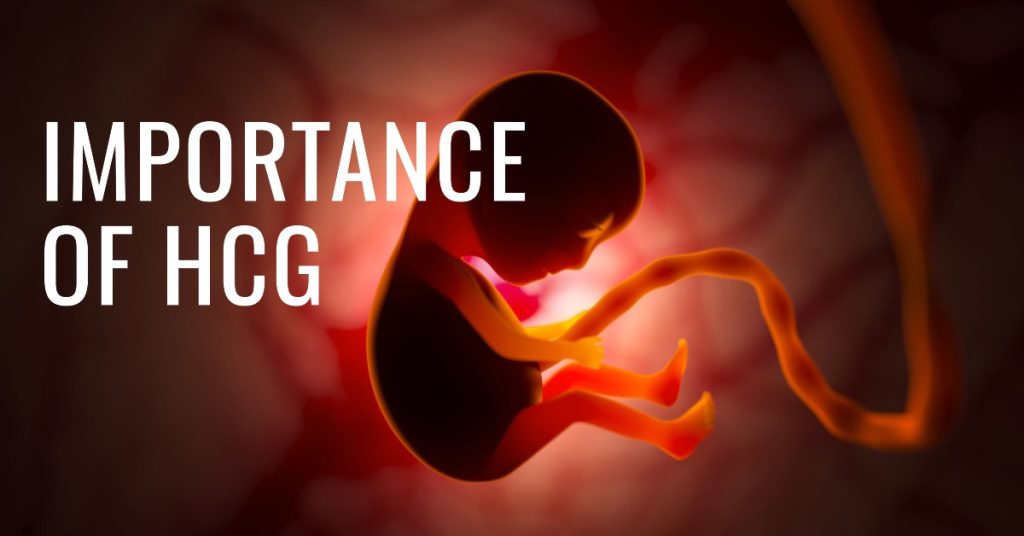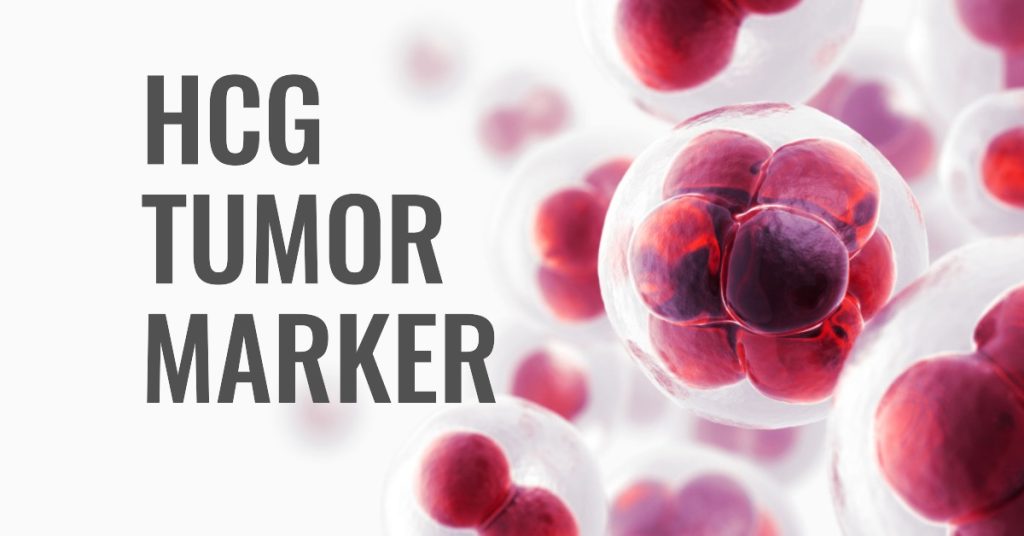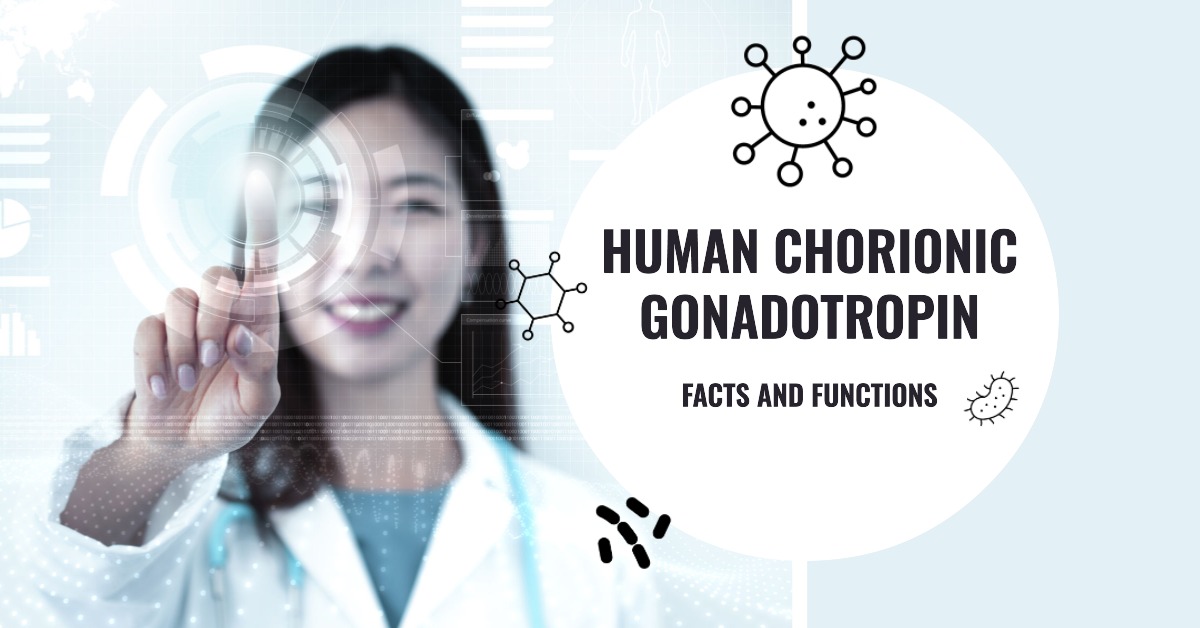Human Chorionic Gonadotropin Hormone (hCG) – Facts & Functions
Key Facts
- HCG’s Primary Role: Human Chorionic Gonadotropin supports pregnancy, ensuring embryo implantation & development.
- Molecular Structure: A complex glycoprotein hormone containing α(alpha) and β(beta) subunits that play a vital part in fertility, hormonal balance, and cancer diagnosis.
- Detecting Pregnancy: Both home and clinical tests help detect hCG levels to determine pregnancy status, reflecting its central significance in prenatal health monitoring.
- TRT Savior: hCG, when used alongside Testosterone Replacement Therapy (TRT), helps maintain essential male reproductive functions and holds promise for men with low testosterone levels.
- HCG & Cancer: HCG serves as a tumor marker for certain cancers like testicular and ovarian cancers—shining light upon potential diagnostic and therapeutic uses.
- Controversial Applications: Despite proposed claims relating to weight loss diets or athletic enhancements, further research remains essential to substantiate its true capabilities.
Introduction
A. Definition and overview of human chorionic gonadotropin (hCG)
Human chorionic gonadotropin or hCG is a hormone produced primarily by the developing placenta after an embryo implants successfully into the uterus. Commonly known as the pregnancy hormone, hCG is crucial in maintaining pregnancy and supporting fetal growth.
B. Historical background and discovery of hCG
In 1927, two German scientists, Selmar Aschheim and Bernhard Zondek, made history by discovering hCG. They noticed that when pregnant female rats were injected with urine from pregnant women, the rodents’ ovaries enlarged due to a specific substance present in the women’s urine — what we now know as human chorionic gonadotropin. “The miraculous product of pregnancy!”, they thought.
C. Importance and role of in human physiology
Believe it or not, hCG plays several vital roles during pregnancy! Produced by trophoblastic cells within the developing placenta, it aids in shaping essential reproductive organs like the corpus luteum and even has potential roles outside pregnancy relating to cancer markers.
“You could think of hCG as a guardian angel for a growing baby!”
Aside from being synonymous with pregnancy tests, what else does it do?

Structure and Function of human chorionic gonadotropin
A. Molecular structure and composition
At its core, hCG is a fascinatingly complex molecule. Structurally unique, it’s known as a glycoprotein hormone – which means it contains both sugar (carbohydrate) and protein components. Comprising two subunits —α(alpha) and β(beta)— the α subunit is shared with other hormones like TSH, LH, and FSH, while the β subunit is unique to hCG.
“Structure lends wings to function like arrows that seek their targets.”
B. Synthesis and production of human chorionic gonadotropin
But where does this wonder hormone come from? Trophoblasts! These cells are vital during pregnancy, forming the outer layer that eventually grows into the placenta. Notably termed “the grand-prix star” among cells for producing six different variants of the hormone! Also contributing to its production are select regions in both men & women such as corpus luteum, pituitary gland, & cancerous tumors.
How about its life story? Usually detected ten days post-conception; levels peak around 8-11 weeks before decreasing slightly — but staying elevated till the baby’s delivery!
C. Mechanism of action and physiological functions
1.Stimulating progesterone production in corpus luteum
Q: How does the hormone show off some magic tricks?
2 Month HCG 5000 IU Incl. Mixing Supplies
Original price was: $230.00.$179.00Current price is: $179.00. Buy NowA: By extending corpus luteum’s expiry date! Normally deteriorating after one cycle (28 days), boosting progesterone by keeping this structure intact aids embryo nurturing.
2.Supporting embryonic development & implantation
Thickened uterine lining = hearty meals for your growing baby! Ensuring proper supply makes sure your little bundle gets essentials like oxygen & nutrients via the placenta.
Remember, human chorionic gonadotropin plays an important part in nourishing your baby!
3.Modulating immune response during pregnancy
It acts as a guardian angel protecting your baby from unexpected hostilities— interactions with cells called Treg – whose job it is to regulate our immunity by dampening excessive reactions- make sure mama’s immune system stays calm & non-aggressive toward the new guest!
4.Potential roles outside of pregnancy (e.g., cancer markers)
Even superheroes have a dark side. So does hCG! Interestingly, some cancer cells—including testicular & ovarian cancers—produce this hormone, giving it ‘tumor marker’ status, helping clinicians detect sinister changes within patients.
A mysterious double-edged sword awaits investigation.
In conclusion, hCG is an enigma worth exploring. Unlocking doors to secrets awaiting gravid knowledge of human physiology; sculpting countless applications in diagnostics and health research. Every eager mind contributes to understanding its true nature.

hCG and TRT in Men
A. The role of hCG in Testosterone Replacement Therapy (TRT)
Heeding the siren call of balance, the hormone once again charts a fascinating course—here to uplift men suffering from low testosterone levels! One emerging application is its use in Testosterone Replacement Therapy (TRT).
“To regain harmony, a little hormonal guidance goes a long way.”
Q: So how does human chorionic gonadotropin perform in this untapped domain?
A: With finesse! It accomplishes this by mimicking the effects of Luteinizing Hormone (LH) & encourages the body’s natural testosterone production. Thus, ensuring preservation of essential functions integral for robust health.
B. Benefits of using hCG in men undergoing TRT
While conventional TRT treatments directly infuse external testosterone, complementing it with hCG brings about significant benefits, such as:
- Conservation of normal testicular volume & function.
- Maintenance and stimulation of sperm production.
- Hormonal backup to minimize possible fertility issues presented by direct testosterone administration.
“Even heroes need support; through unity emerges resilience.”
C. Contemplating caveats: Risks and concerns
As with any treatment, understanding potential drawbacks becomes vital for mitigating harm. Here are some concerns to weigh carefully while considering human chorionic gonadotropin for TRT:
- Potential side-effects like mood swings, acne breakouts or breast development (gynecomastia).
- The need for medical supervision during prolonged use or higher doses.
- Continually monitoring results to ensure dose-specific nuances are factored into personalized treatment plans without undermining one’s journey toward healing.
By exploring uncharted waters within male hormonal balance, the hormone unfolds in all its splendor. Equipped with delicate precision, it treads carefully against the backdrop of human suffering — testament to a future poised for innovation and progress.
Detection and Measurement of hCG
A. Clinical methods for detecting and measuring
1. Pregnancy tests and their principles
Do you ever wonder how a pregnancy test works? It’s all about sensing the presence of hCG! The iconic red-blue lines emerging on a home pregnancy test reveal magic trapped within little devices called lateral flow assays. They contain tiny antibodies specifically designed to attach to the β subunit of human chorionic gonadotropin!
“Home pregnancy tests – remarkable marvels that predict life-changing news.”
Q: How do they know when it’s time for celebration?
A: When there’s enough hormone in your urine (usually around 25 mIU/mL), these preggo-testers start turning colors—bringing you the ultimate evidence.
2. Quantitative measurement in clinical settings
While home pregnancy tests are striking, blood tests performed at clinics can provide even more precision! These radioimmunoassays, also relying on antibody-based technology, use radiolabeled molecules which emit signals proportional to the amount of hCG in one’s blood.

B. Levels during pregnancy
1. Normal hCG levels during different stages of pregnancy
What would you call an unpredictable rollercoaster ride? hCG levels. While expecting, they peak by week 8-11, only to dwindle afterward with plateaus that maintain themselves throughout gestation.
Here’s a glimpse:
- 3 weeks since last period: ~5-72 mIU/mL
- 4 weeks: ~10-708 mIU/mL
- 5 weeks: ~217-8,245 mIU/mL
- … and so on; but remember, this can vary among individuals!
2. Abnormal levels of human chorionic gonadotropin and their implications
Sometimes, hCG levels could go astray; e.g., if they’re too low or progress poorly, it may signal an ectopic pregnancy (when the embryo implants outside your uterus), a possible miscarriage, or miscalculated dating. If skyrocketing gonadotropin hormone is observed, watch out! It might be indicative of a multiple pregnancy (more than one baby) or other complications like gestational trophoblastic disease.
Time for healthcare providers to step up & face these adversaries head-on.
Through the remarkable labyrinth that is hCG, we see how decoding this hormone paves a path toward understanding our bodily capabilities & struggles. To measure it – a conduit to precious knowledge about new life!
Clinical Applications of hCG
A. Use of human chorionic gonadotropin in diagnosing and monitoring pregnancy
1. Confirming pregnancy and estimating gestational age
Never underestimate the power of a hormone playing doctor. Determining whether you’re expecting all comes down to detecting the hormone levels in your body, either via urine (home tests) or blood (clinic tests). Blood tests even shed light on how far along you are by revealing the exact amount of circulating hCG.
“hCG – harbinger of delight or sorrow, bringing forth the undeniable truth.”
2. Identifying ectopic pregnancies or miscarriages
Wonder why healthcare providers insist on monitoring human chorionic gonadotrophin throughout early pregnancy? Witnessing deviations in its progression might indicate potential complications, like ectopic pregnancies and tragic miscarriages.
Q: How vigilant must these guardians be?
A: Watchful — spotting trouble before it strikes!
3. Monitoring human chorionic gonadotropin levels in high-risk pregnancies
For those who face high-risk pregnancies due to factors like advanced maternal age, medical conditions, or past complications, closer supervision becomes crucial – after all , who dares toy with a fragile existence?
Human Chorionic Gonadotrophin levels serve as an essential parameter for guiding clinicians through such uncertain times.

B. Tumor marker in cancer diagnosis and treatment
1. Human chorionic gonadotrophin in testicular and ovarian cancers
Can good intentions bring unwanted consequences? Absolutely! Despite being principally known for nurturing life, lingering traces of this hormone produced by tumors can act as red flags during cancer screenings.
On the diagnosis battlefield, even heroes can have villainous traits.
2. Other cancers associated with elevated hormone levels
No malignancy’s impenetrable; as long there’s intelligence at stake! Elevated hCG has been observed in other cancers of the pituitary gland or cancers that metastasize into the abdomen from visceral organs.
“A beacon revealing the veiled enemy, hCG emerges as a resourceful ally.”
3. Therapeutic applications of cancer treatment
Just when you thought chorionic gonadotrophin had shown all its cards! Boasting an impressive résumé, it’s now being considered a key player in combination treatments for specific types of tumors, especially testicular cancers. Talk about an unexpected therapy arsenal!
“In defiance of its very nature, hCG ponders: to save or destroy?”
Combining the best and worst of two worlds, human chorionic gonadotrophin presents itself as both angel and demon. Its countless clinical applications unravel powerful tools for pursuing healthier lives; yet lurking beneath lie prospects within disease detection & eradication. Whichever face we choose to unveil depends on our comprehension & desire to illuminate hidden secrets behind this extraordinary molecule.
Controversies and Misuse of human chorionic gonadotrophin

A. Controversies surrounding hCG and weight loss
1. The hCG diet and its claims
Beyond the realm of pregnancy, let’s wades into murkier waters. Enter the controversial hCG diet – an enticing concoction blending rapid weight loss with a questionable low calorie count (only 500 calories/day). Despite marketers praising its ability to burn stubborn fat without exercising, experts remain wary.
“An audacious claim beckons scrutiny: Can helping create life mercilessly destroy fats?”
Q: Is the hCG diet a miracle or menace?
A: Tread cautiously—claims often call for investigative prowess!
2. Criticisms and lack of scientific evidence
Opponents denounce the diet as too good to be true, citing:
- Potential side effects like gallstones, blood clots, and nutritional deficiencies
- Lack of robust scientific evidence proving long-term efficacy & safety
- Potential placebo effect (losing weight from calorie restriction rather than actual influence from the hormone)
Recklessly entrusting one’s fate to questionable regimes weighs heavy on a delicate scale.
B. Misuse of hCG in athletic performance enhancement
1. Use as a performance-enhancing substance
Is there no sphere left unchartered by this rebellious hormone? Although synthetically available for fertility treatments, some unscrupulous athletes misuse it for nefarious purposes: boosting testosterone levels.
When administered alongside anabolic steroids that ultimately alter testosterone production negatively, enterprising folks reach for artificial means to bring back balance.
Q: What could go wrong in this calculated gamble?
A: The troubled pursuit of glory often leaves honor behind!
2. Anti-doping regulations and detection methods
The World Anti-Doping Agency (WADA) lists human chorionic gonadotrophin as a banned substance for male athletes. From blood tests to exhaustive initiatives in suppressing drug use, they remain vigilant, unfaltering.
But there’s light at the end of this dark tunnel; novel detection methods are emerging to curb foul play, including advanced anti-doping measures like the athlete biological passport – a tool designed to track any physiological changes potentially caused by doping over time.
“A race against deception: Who eventually prevails?”
In conclusion, hCG navigates through stormy waters of controversy fraught with criticism and misuse. Studying it enables us to better understand its true nature, while remaining ever-watchful of potential scams providing false hope & harmful practices. Encouraging honest competition while upholding justice in healthcare ensures that we harness it’s full potential for the betterment of humankind.

Future Perspectives and Research Directions
A. Advancements in hCG-related research and technology
Armed with today’s ever-evolving scientific prowess, chorionic gonadotrophin stands poised to unlock newfound mysteries. Recent discoveries concerning its molecular variants & roles in extraplacental sites have piqued the interest of researchers globally.
“Future horizons beckon as hCG unfurls itself under watchful scrutiny.”
Q: What could burgeoning advancements unleash?
A: Uncharted territory within pregnancy, diagnostics, therapy, and beyond!
B. Potential therapeutic applications beyond current uses
As scientists continue piecing together the enigma that is human chorionic gonadotrophin, they uncover potential therapeutic applications across a diverse range of ailments. Imagine harnessing hormonal benevolence to alleviate symptoms of autoimmune disorders or even battling tumors with newfound weaponry!
“Who dares predict the trajectory of such a versatile molecule?”
C. Emerging areas of study and unanswered questions
Among emerging topics illuminated by research are:
- Factors influencing hCG production & degradation
- The role of human chorionic gonadotrophin in modulating pre-& post-natal neurological function
- Its significance in male reproductive biology & potential relation to prostate cancer
“Are we inching closer to clarity or further tangled in the enigma?”
Sailing into unexplored waters on this grand journey toward enlightenment continues to captivate eager minds worldwide. Awaiting them — a labyrinthine tapestry; myriad junctures lying at their whim.
In conclusion, embracing future advancements offers pathways toward understanding life from its genesis onward. As we delve deeper into this intricate realm uncovering cryptic secrets trapped within molecules & cells, taking fresh strides for treatment becomes reality – breathing hope into weary hearts & preparing our world for remarkable change — all powered by the ceaseless pursuit of knowledge called science.
Conclusion
A. Recap of key points about human chorionic gonadotropin
In this captivating journey, we’ve unearthed fascinating aspects of human chorionic gonadotrophin (hCG):
- Its crucial role in pregnancy by supporting embryo implantation & development.
- The molecular complexity that drives its multifaceted functions.
- Detection via both home and clinic tests for critical pregnancy insights.
Moreover, we delved into the contentious duality of hCG being related to cancer diagnosis— illuminating untapped potentials while exploring dark alleys within the world of hormone regulation.
B. Importance of further research and understanding of hCG
By fostering a thorough comprehension of the hormone, we unlock a treasure chest brimming with powerful tools for monitoring pregnancy, aiding fertility, and confronting illnesses like cancer. Nevertheless, challenges await; discerning myth from reality and not succumbing to false promises requires unwavering scientific dedication.
For instance:
- “Physiology, Chorionic Gonadotropin – StatPearls” from the National Center for Biotechnology Information (NCBI) provides an overview of hCG, including its production, function, and clinical applications.
- “Human Chorionic Gonadotropin: The Pregnancy Hormone …” from the US National Library of Medicine’s PubMed Central (PMC) discusses the role of the hormone in pregnancy and its other functions.
- “Human Chorionic Gonadotropin” is an article on PubMed that explains what hCG is, how it is produced, and its clinical applications.
- “Human Chorionic Gonadotropin” from StatPearls provides a brief overview of it and its role in pregnancy.
With emerging applications suggested for weight loss and athletic enhancements only validating their true magnitude through rigorous investigation clears confusion from our path forward .
C. Final thoughts on the significance of hCG in human health and reproduction
hCG invites us to witness life’s marvels unfolding through intricate biochemical tapestries, guiding curious souls to probe deeper into nature’s labyrinthine secrets. As we navigate uncharted realms within biology & medicine, remaining mindful that healthy skepticism must shadow curiosity enables thoughtful advancements – steering humankind toward a future steadfastly anchored by knowledge.
FAQs
Why is hCG important in pregnancy?
hCG is important in pregnancy because it plays several crucial roles, such as:
1. Supporting the corpus luteum, which in turn produces progesterone that helps maintain a thickened endometrium (uterine lining) necessary for a successful implantation of the embryo.
2. Ensuring proper embryonic development by providing essential nutrients via the placenta.
3. Modulating the maternal immune response to prevent attacks on the developing fetus, which contains foreign genes from the partner or donor.
These critical functions make hCG vital for a healthy and viable pregnancy.
Why would a man take human chorionic gonadotropin?
A man might take human chorionic gonadotropin (hCG) for reasons such as:
1. Fertility issues: Boosting testosterone levels, improving sperm production and quality, or treating certain conditions like hypogonadotropic hypogonadism.
2. Testosterone Replacement Therapy (TRT): As a complementary treatment to stimulate the body’s natural testosterone production and preserve testicular function while undergoing TRT.
3. Weight loss: Though controversial, some men take hCG as part of the hCG diet plan for weight reduction, which is not scientifically proven or recommended by health experts.
Does hCG increase fertility?
Yes, hCG can increase fertility in both men and women when used under medical supervision. In women, hCG is often used to stimulate ovulation by mimicking the Luteinizing Hormone (LH), which helps mature and release eggs from the ovaries. In men, hCG can boost testosterone levels, enhance sperm production and quality, and treat certain conditions related to low or impaired hormone production (e.g., hypogonadotropic hypogonadism). However, using hCG for fertility purposes should always be done under a healthcare professional’s guidance to ensure safe and effective outcomes.
How does hCG make you feel?
hCG itself usually doesn’t cause significant changes in how you feel. However, during pregnancy, increased hCG levels can contribute to common symptoms such as:
– Morning sickness or nausea
– Fatigue and tiredness
– Frequent urination
In men or women using hCG for fertility treatments or other medical reasons, potential side effects might include:
– Bloating
– Abdominal pain or cramps
– Mood swings
– Headaches
Individuals react differently to hormonal changes, so experiences with hCG may vary. It’s essential to consult a healthcare provider if any unusual or severe symptoms occur while taking hCG.
Can folic acid increase hCG?
Folic acid, a B-vitamin, does not directly increase hCG levels. However, it plays a crucial role in promoting overall maternal and fetal health during pregnancy. Folic acid helps reduce the risk of neural tube defects in the developing baby, and ensuring adequate intake is highly recommended for women trying to conceive, pregnant women or even those taking hCG treatment for fertility issues. While folic acid does not impact hCG levels directly, it contributes to a healthier pregnancy environment that may indirectly influence hormone production.
Can stress affect hCG levels?
Stress is not known to directly affect hCG levels, but it is important to note that mental and emotional stress can negatively impact your overall health. Chronic stress may lead to hormonal imbalances and irregular menstrual cycles, which could indirectly affect factors— such as conception timing or implantation of the embryo—that are associated with hCG production. Thus, managing stress might be beneficial for maintaining a healthy balance in your body during pregnancy or while trying to conceive.

Health nut turned blogger, spreading the wellness bug with a side of humor. Dishing out nutritious advice, fitness antics, and wellness wisdom, all while keeping health journeys as fun as a barrel of kale!















Leave a Reply